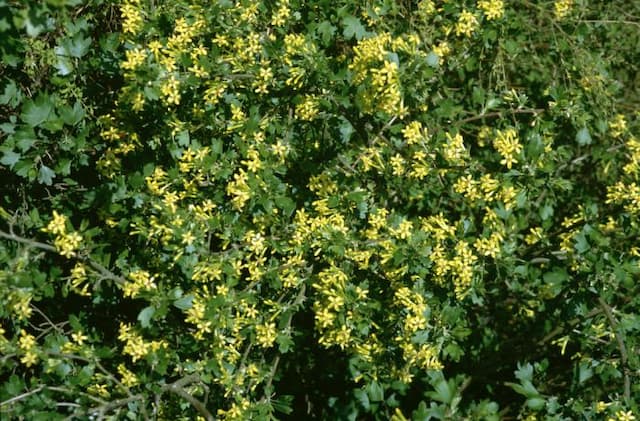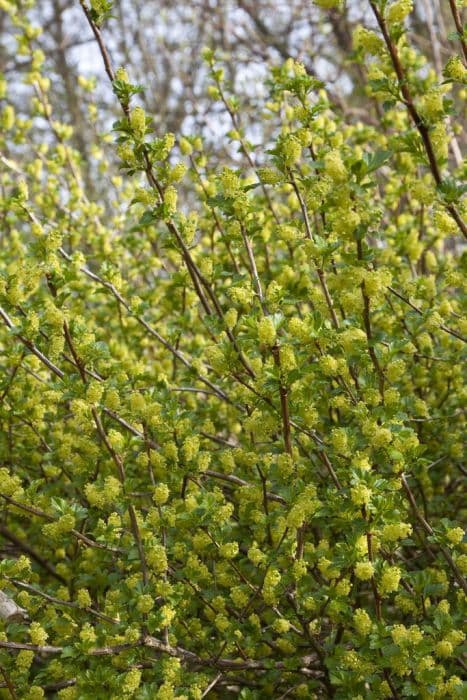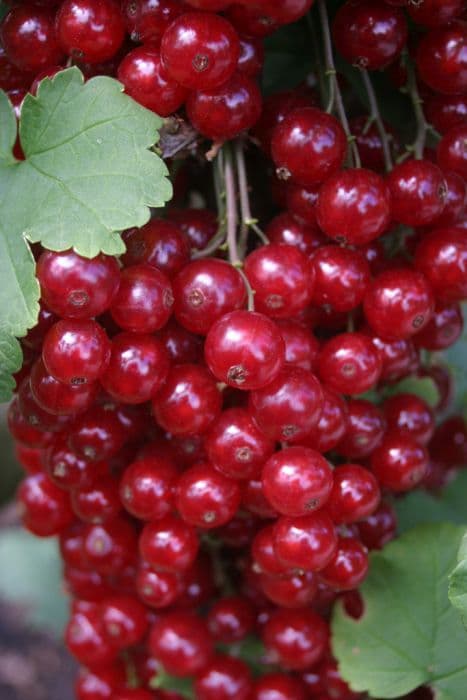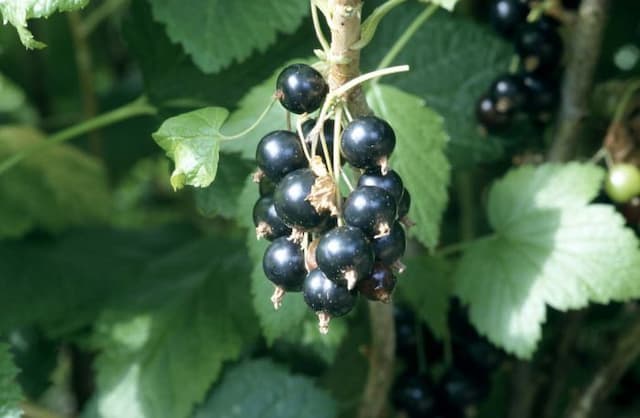Black currant Ribes nigrum 'Ben Sarek' (B)

ABOUT
Ribes nigrum 'Ben Sarek', commonly known as blackcurrant, is a deciduous shrub known for its distinctive features. The plant is characterized by its leaves which are broad, with three to five lobes and a serrated edge. These leaves often have a shiny surface on top with a matte underside and may exude a strong, aromatic scent when crushed. During the blooming period, the blackcurrant bears small, tubular flowers that are usually found in clusters called strigs. These flowers are typically a pale green or yellowish color, which can add a subtle splash of color to the appearance of the plant. After flowering, the plant produces its most distinctive feature: the fruit. The blackcurrant bears fruit that is dark purple-black when ripe, which are small, spherical berries. These berries are usually clustered together on the stems and are known for their tart flavor, which is widely used in culinary applications. The combination of the dark fruits and the bright green foliage can make for an attractive contrast in a garden setting.
About this plant
 Names
NamesFamily
Grossulariaceae.
Synonyms
Blackcurrant, European Black Currant, Black Currant.
Common names
Ribes nigrum 'Ben Sarek'.
 Toxicity
ToxicityTo humans
Blackcurrant 'Ben Sarek' is generally considered safe for human consumption, particularly the berries which are commonly used in cooking and for their nutritional benefits. There is no widespread evidence to suggest toxicity to humans, and blackcurrant products are widely consumed without reports of poisoning. As with any plant, individual allergies can occur, but these are not common.
To pets
Generally, blackcurrant, including the 'Ben Sarek' variety, is not known to be toxic to pets such as dogs and cats. The berries could be eaten in moderation. However, each animal may react differently, and some may have sensitivities or allergic reactions. If a pet ingests a large amount of the plant and shows signs of indigestion or discomfort, it is advisable to consult a veterinarian.
 Characteristics
CharacteristicsLife cycle
Perennials
Foliage type
Deciduous
Color of leaves
Green
Flower color
Greenish-yellow
Height
3-4 feet (0.9-1.2 meters)
Spread
3-4 feet (0.9-1.2 meters)
Plant type
Shrub
Hardiness zones
5
Native area
Europe
Benefits
 General Benefits
General Benefits- High in Nutrients: Ribes nigrum 'Ben Sarek', commonly known as blackcurrant, is rich in vitamins and antioxidants.
- Edible Fruits: It yields edible berries that are commonly used in jams, jellies, syrups, and beverages.
- Attractive to Wildlife: Blackcurrants attract pollinators such as bees and can also provide food for birds.
- Easy to Grow: Blackcurrant 'Ben Sarek' is known for being easy to cultivate and is hardy in a variety of conditions.
- Compact Growth: This cultivar has a compact growth habit, making it suitable for small gardens or spaces.
- Cold Hardy: It is resistant to cold temperatures, which makes it suitable for growing in cooler climates.
- Landscape Use: Blackcurrant bushes can be used in landscape design for their aesthetically pleasing foliage and fruits.
- Culinary Versatility: The fruit of blackcurrant 'Ben Sarek' can be used in a wide range of culinary dishes beyond desserts, including savory sauces and garnishes.
 Medical Properties
Medical Properties- Rich in Vitamin C - Black currant (Ribes nigrum 'Ben Sarek') fruits are known to have high vitamin C content, which supports the immune system.
- Anti-inflammatory - The plant contains gamma-linolenic acid (GLA), a type of omega-6 fatty acid, that may help reduce inflammation in the body.
- Antioxidant properties - Black currant berries have high levels of antioxidants, which can protect cells from oxidative stress and may reduce the risk of chronic diseases.
- Anthocyanins presence - These are flavonoid compounds in the fruit that may support eye health and improve night vision.
 Air-purifying Qualities
Air-purifying QualitiesThis plant is not specifically known for air purifying qualities.
 Other Uses
Other Uses- Blackcurrant 'Ben Sarek' branches can be used for basket-weaving due to their flexibility and strength after being properly treated and dried.
- The strong natural dye from blackcurrant skins can be used in textile dyeing, imparting a deep, purple color to fabrics.
- Oil extracted from blackcurrant seeds is used as a flavoring agent in culinary preparations due to its intense, tart flavor.
- The pectin-rich fruit of blackcurrant is ideal for making homemade fruit preserves, such as jams and jellies.
- Leaves of the blackcurrant can be used to infuse vodka or gin, imparting a unique and aromatic flavor to the alcohol.
- As a natural pest repellent, blackcurrant leaves can be crushed and scattered around other plants to deter aphids and other pests.
- The acidic nature of blackcurrant soil requirements can help in conditioning garden soils that are too alkaline for other plant species.
- Dried blackcurrant leaves can serve as a base for homemade potpourri, contributing a pleasant fragrance to a room.
- Blackcurrant fruits can be used in baking, adding a distinctive tartness to pastries, cakes, and tarts.
- The wood from pruned blackcurrant bushes can be repurposed as garden stakes for supporting other plants in the garden.
Interesting Facts
 Feng Shui
Feng ShuiThe Blackcurrant is not used in Feng Shui practice.
 Zodiac Sign Compitability
Zodiac Sign CompitabilityThe Blackcurrant is not used in astrology practice.
 Plant Symbolism
Plant Symbolism- Healing: Blackcurrant is traditionally associated with medicinal properties, as many parts of the plant are used in herbal remedies.
- Prosperity: The abundant fruit production of the blackcurrant can symbolize wealth and prosperity.
- Protection: In folklore, some believe that blackcurrant bushes could ward off evil spirits and negative energies.
- Knowledge: The complex flavors of the blackcurrant might be seen as a metaphor for the many layers of wisdom and learning.
 Water
WaterBlack currants, including the 'Ben Sarek' variety, prefer consistently moist soil and should be watered deeply once a week, providing 1 to 1.5 gallons of water each time during the growing season. If the weather is particularly dry or hot, you might need to water twice a week. It's crucial not to let the soil dry out completely, as this can stress the plant and reduce fruit quality. Adjust the watering schedule during rainy periods to avoid waterlogging, as black currants do not tolerate standing water.
 Light
LightBlack currants, such as 'Ben Sarek,' thrive best in full sun to partial shade conditions. They should be planted in a spot that receives at least 4 to 6 hours of sunlight daily to ensure good fruit production. While tolerant of light shade, the sunniest location possible will lead to the best yield and healthiest growth of the plant.
 Temperature
Temperature'Ben Sarek' black currant plants are hardy and can withstand winter temperatures as low as -40°F, which is often colder than most places experience. They grow best in temperatures ranging from 60°F to 75°F during the growing season. It's important to protect the plants from late spring frosts which can damage new growth and reduce the crop yield.
 Pruning
PruningPruning is essential for 'Ben Sarek' black currant to maintain plant vigor, facilitate good air circulation, and ensure high-quality fruit production. Prune the plants in late winter or early spring before new growth begins, removing all dead wood and about a third of the oldest branches each year. This encourages the growth of new, fruit-bearing shoots and should be done annually for the health and productivity of the plant.
 Cleaning
CleaningAs needed
 Soil
SoilBlackcurrant 'Ben Sarek' thrives in well-drained, fertile soil rich in organic matter with a pH between 6.0 and 6.5; a mix with equal parts garden soil, compost, and peat would be ideal.
 Repotting
RepottingBlackcurrant 'Ben Sarek' does not typically require repotting as it is grown outdoors; it should be replanted only when necessary, such as when moving or dividing the plant.
 Humidity & Misting
Humidity & MistingBlackcurrant 'Ben Sarek' is adaptable to outdoor humidity levels and does not require specific humidity conditions when grown outside.
 Suitable locations
Suitable locationsIndoor
Not suitable for indoor growing.
Outdoor
Plant in sun, well-drained soil, water regularly, prune yearly.
Hardiness zone
5-8 USDA
 Life cycle
Life cycleThe life cycle of Ribes nigrum 'Ben Sarek', more commonly known as Blackcurrant 'Ben Sarek', begins with seed germination, which requires stratification to break dormancy. Following germination, the seedling emerges and grows into a small shrub, with a period of vegetative growth characterised by the development of lobed leaves and woody stems. After one to two years, it reaches maturity and enters the reproductive stage, producing clusters of small, greenish-white flowers in the spring. These flowers are pollinated by insects, leading to the formation of blackcurrant fruit which ripens in the summer. Once the fruits are harvested, the plant enters a dormant phase in the autumn and winter, conserving energy for the next growing cycle. The blackcurrant shrub is perennial, capable of fruiting for up to 15 years or more with proper care and pruning.
 Propogation
PropogationPropogation time
Early Spring
The most popular method of propagating the black currant 'Ben Sarek' involves hardwood cuttings. This technique is typically performed in late fall or early winter, after the leaves have dropped and the plant is dormant. To propagate by this method, healthy, mature stems from the current or previous year's growth are selected. A cutting of about 6 to 8 inches (15 to 20 centimeters) is made, ensuring it has several buds. The lower end of the cutting is then inserted into well-draining soil or a potting mix, leaving several buds above the soil surface. The soil should be kept moist but not waterlogged to encourage root development. Within a few weeks to months, the cutting should start to produce roots, at which point it can eventually be transplanted to its permanent location in the garden.








